| Author |
Message |
    
john_drabik
Member
Username: john_drabik
Post Number: 5
Registered: 12-2005
| | Posted on Friday, January 20, 2006 - 07:01 am: | 




|
I`m looking to fabricate two intake check valves for my two cycle 15 hp Mianus engine. I have no clue whether they were a poppett or reed valve type. I do know they were 1-1/4 NPT but thats about all. Can someone give me some direction to find some new or used, or dimensions/descriptions so I can try to machine my own?
Thankyou, John Drabik |
    
thomas
Senior Member
Username: thomas
Post Number: 300
Registered: 07-2002

| | Posted on Friday, January 20, 2006 - 06:32 pm: | 




|
I'm posting some pictures of the intake check on my Mianus single. It's about a 1" NPT check. I took several pictures of another similar valve showing some of the insides. In general, it uses an axial mushroom valve held to the seat by a light spring. The crankcase vacuum sucks it open and also draws a charge of gas through the carb.
Pictures to follow show the check on my engine, inside with valve closed, open then the spring end. |
    
thomas
Senior Member
Username: thomas
Post Number: 301
Registered: 07-2002

| | Posted on Friday, January 20, 2006 - 06:34 pm: | 




|
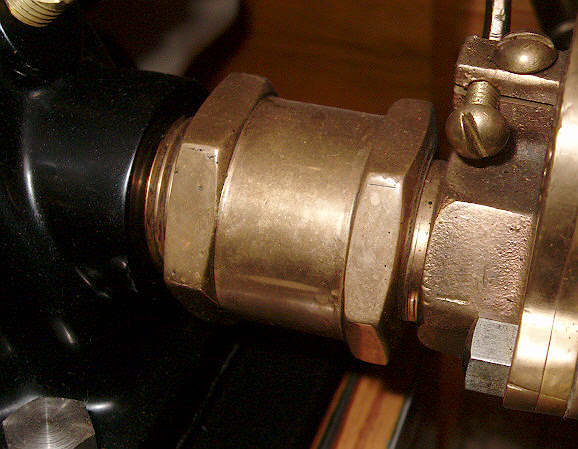 |
    
thomas
Senior Member
Username: thomas
Post Number: 302
Registered: 07-2002

| | Posted on Friday, January 20, 2006 - 06:37 pm: | 




|
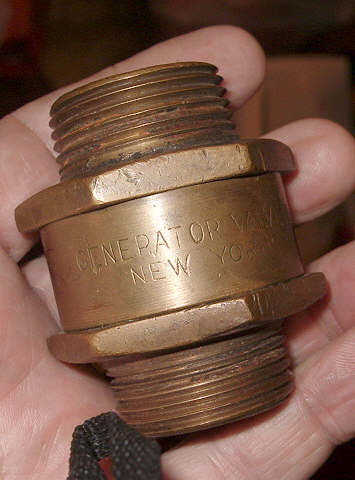 |
    
thomas
Senior Member
Username: thomas
Post Number: 303
Registered: 07-2002

| | Posted on Friday, January 20, 2006 - 06:39 pm: | 




|
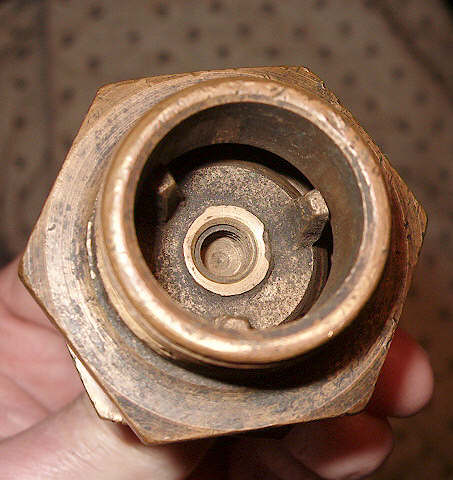 |
    
thomas
Senior Member
Username: thomas
Post Number: 304
Registered: 07-2002

| | Posted on Friday, January 20, 2006 - 06:41 pm: | 




|
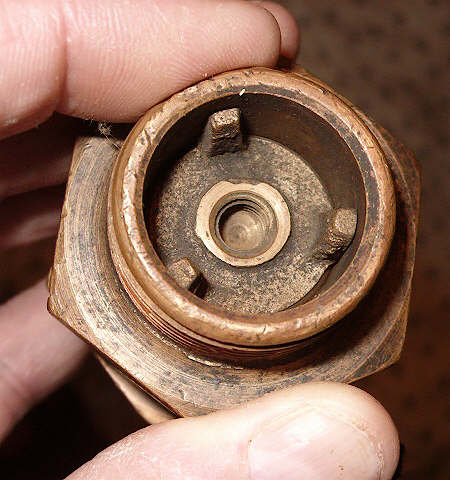 |
    
thomas
Senior Member
Username: thomas
Post Number: 305
Registered: 07-2002

| | Posted on Friday, January 20, 2006 - 06:43 pm: | 




|
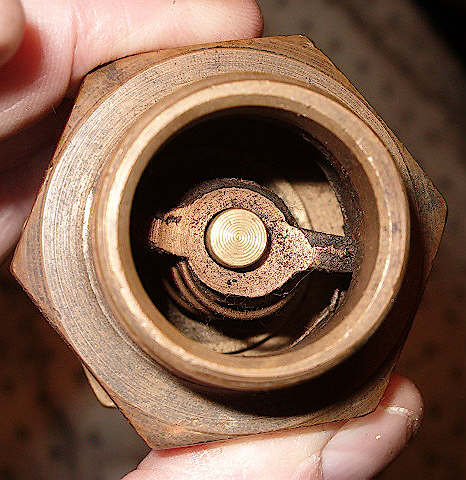 |
    
john_drabik
Member
Username: john_drabik
Post Number: 7
Registered: 12-2005
| | Posted on Tuesday, January 24, 2006 - 12:28 am: | 




|
Yesterday I traveled to four large plumbing supply houses with a sample valve loaned from Ernie. Found lots of check valve styles but nothing that duplicates the action of my sample. Tomorrow I hope to email Thomas`s descriptive photos to a few more suppliers not in driving distance.
Thankyou, Thomas and Ernie.
So far this this the largest hurdle to jump on this engine.
Has anyone ever had any sucess at all with other than "original equipment" type valves? If so what type or style? |
    
boyd_guard
Member
Username: boyd_guard
Post Number: 6
Registered: 06-2005
| | Posted on Tuesday, January 24, 2006 - 02:29 am: | 




|
Associate chore-boy that I had used a ball check valve, about 3/8 dia ball, it was gravity closed.
Can`t see why a spring loaded one in the plumbing line could`nt do the job. |
    
john_drabik
Member
Username: john_drabik
Post Number: 8
Registered: 12-2005
| | Posted on Tuesday, January 24, 2006 - 07:04 am: | 




|
This valve operates in a vacuum atmosphere, not a fluid pressure by gravity situation like the fuel inlet valve between the tank and carb.
It mounts between the carb and the intake port of a 3 port two cycle engine.
Maybe thats why I`m having a problem locating a valve. Perhaps the terminology I should be using is a "vacuum operated check valve" to better describe its use and action.
Thanks, Boyd Guard, in a roundabout way I think youve jogged my brain for a better description of this valve. |
    
barry
New member
Username: barry
Post Number: 1
Registered: 01-2006
| | Posted on Tuesday, January 24, 2006 - 12:51 pm: | 




|
I built a Test Bench with full instrumentation which I use to evaluate performance of my two cycle marine engines. One test compared the operation of a three port engine to the same engine arranged as a two port engine. I purchased a 1" bronze check valve at a local hardware store to make the two port conversion. The construction of this valve is same as the one shown in the Thomas post. The valve cost me $11.50 (Canadian). Please refer to the two images attached to this post.
Barry
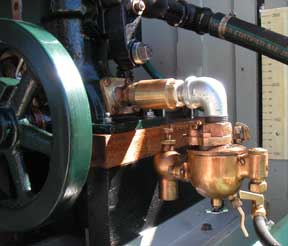
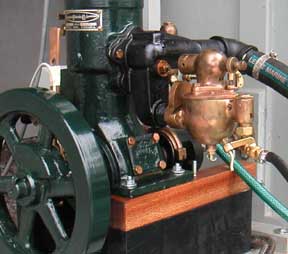 |
    
john_drabik
Member
Username: john_drabik
Post Number: 9
Registered: 12-2005
| | Posted on Tuesday, January 24, 2006 - 01:41 pm: | 




|
Its as simple as that? You didnt have to modify the store bought check valve at all?
Please post back as I`m beating my brains out over this point of consternation John |
    
richardday
Senior Member
Username: richardday
Post Number: 525
Registered: 11-2003

| | Posted on Tuesday, January 24, 2006 - 02:59 pm: | 




|
If you take a typical swing check valve and arrange a phosphor bronze spring to promptly return the check to the seat it can be made to work. Some marine checks were arranged so one could like a needle valve adjust the spring tension/pressure under load to permit optimum operation of the engine. Palmer actuall sold a mixing valve that must have started out in their early experiments as a typical swing check. They added the spring control and needle valve to the small port on the seat and a control that determined the lift calling it the Slow Down valve. They sold this valve from 1895 until about 1907. You find them in 3/4",1", 1-1/4" and 1-1/2" NPT sizes. |
    
barry
New member
Username: barry
Post Number: 2
Registered: 01-2006
| | Posted on Tuesday, January 24, 2006 - 05:28 pm: | 




|
John,
I did not modify the check valve. You should be able to purchase a valve at any hardware store that sells pumps, possibly Home Depot.
When I tested the engine loaded to 900RPM it developed 2.5HP (engine is 3.25”B x 3”S) when operating as a three port. With all conditions the same except converted to the two port configuration the output was about 10% less as the engine would not rev to 900. Possibly as the less negative pressure in the crankcase during the compression stroke must also compress the check valve spring to open the check valve, fuel transfer may therefore be reduced.
You will note by referring to the images that I cut the spring back to reduce spring force.
I will repete the tests when the weather warms to determine if less spring force results in
improved performance.
Regards
Barry
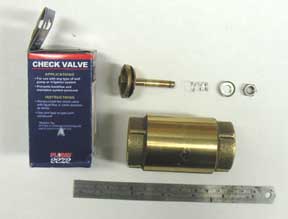

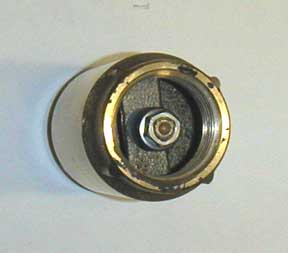
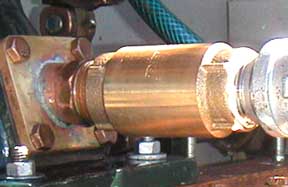 |
    
thomas
Senior Member
Username: thomas
Post Number: 321
Registered: 07-2002

| | Posted on Tuesday, January 24, 2006 - 05:51 pm: | 




|
The check valve illustrated and explained so well by Barry is the SAME one I bought (bought two of) to replace the water checks on the piston water pump on my Dunn Twin. They were purchased from a big plumbing supply Co. here (Sage Supply). They are very positive BUT
(my opinion only) the spring is a bit too strong for a crankcase check. I would "tinker" with the spring tension for CC use. I guess the rubber is gas proof (?) |
    
andrew
Moderator
Username: andrew
Post Number: 1357
Registered: 11-2001

| | Posted on Tuesday, January 24, 2006 - 06:40 pm: | 




|
Great discussion!
I will probably move this to the "Carburetor, Vaporizer, Mixer" category later so that it might be easier for others to find.
Here is a link to a page on the McMasterCarr website that shows what I think is the same valve being described by Barry and Thomas. They might be able to confirm.
You will have to scroll down to the bottom of the page, items desctiption:
Brass NSF-Certified Spring-Loaded Piston Check Valves with Metal Seats
Thanks. |
    
barry
New member
Username: barry
Post Number: 3
Registered: 01-2006
| | Posted on Wednesday, January 25, 2006 - 01:33 pm: | 




|
Richard and Thomas’s posts referred to the check valve spring force. I agree that this will affect engine performance. Here are my thoughts ………
I plan to continue my investigation to determine whether a two-port engine will out perform a three-port engine… maybe discover why all modern two cycle engines ( lawn mowers, jet boats, weed whackers etc) are two port engines This is an ideal use of my test bench as using the bench I can operate an engine under load and record performance….then make one change (for example change the check valve spring force) then again record engine performance. Thus it is possible to quantify any increase (or decrease). With this information a calculated change can then be made and effect of this change evaluated and cycle repeated until an optimum condition is reached.
Since I am able to easily convert the same engine from two-port to three-port, then when the optimum two-port set up is established, performance can be compared to optimum three-port operation.
Here is bit of supposition regarding what happens inside a crankcase. In the case of a two-port engine fuel mix enters the crankcase gradually during the full 180 degree compression stroke. The negative pressure (vacuum) to cause fuel mix transfer is minimal. On the other hand, fuel mix enters a three-port crankcase all at once (with a puff) at the end of the compression stroke. The negative pressure (vacuum) is much greater.
( When I use the term “fuel mix” I am referring to gasoline and air not gasoline and oil)
However when the piston of a three-port engine begins downward travel the fuel inlet port remains open for a considerable time … recall that at the beginning of the downward (or upward) stroke large amount of crank rotation produces a small amount of piston movement, so it takes a lot of crank rotation (time) to close off the fuel inlet port. Thus some fuel mix is pushed back out of the crankcase.
For the two-port, the selection of check valve spring becomes important. A very weak spring is desirable so that the least vacuum pulls the valve open. However the spring must be strong enough to ensure rapid and positive seating of the check valve when the piston starts down as to avoid fuel mix back flow. My opinion favors the two-stroke setup with respect to least amount of fuel mix back flow. I might try a check valve with the
three-port set up to possibly reduce blow back and maybe increase power.
Engine power is dependent upon the amount of fuel mix that is available for combustion, more fuel mix .. more heat .. higher pressure .. more force on piston .. more power to drive a boat.
The above analysis relates to fuel waste because of blow back resulting in less power.
The other limitation is the ability of the carburetor to transfer gasoline into the air steam. One might observe that a Schebler carburetor does not have a venturi. Bernoulli’s Principle still applies. When air is flowing through the carburetor, the pressure within the air stream is less that the air pressure outside of the air stream. This higher pressure outside pushes down on the fuel in the carburetor bowl and forces it into the lower pressure air steam. When air speed is higher, air stream pressure is lower. Therefore more gasoline can be transferred into the air stream during the same time interval.
The carburetor of a two-port engine transfer a smaller quantity of gasoline into the air stream over a longer time interval than a three port where more fuel is transferred during a short time interval. So the question is … which results in the greater amount of fuel mix in the combustion chamber ?
More supposition, this time relating to carburetor function … a venturi causes a much higher air stream velocity and therefore much lower pressure at the carburetor nozzle. Therefore a much smaller nozzle opening is needed to transfer the required quantity of gasoline. Fuel atomization results. In the case of the Schebler carburetor, there is no venturi and therefore insufficient pressure difference to produce much if any atomization.
Carburetor fuel atomization may not be necessary anyway as atomization probably occurs within the crankcase, aided by the spinning crank, also during rapid fuel transfer from the crankcase to combustion chamber aided by the rough surface of the transfer passage and in some cases transfer port baffles.
On the other hand, four stroke engines require atomized fuel as fuel mix is transferred directly into the combustion chamber.
Andrew in his posting provided a link to McMasterCarr catalogue. Page 437 lists two valves that should work, 4216K series and 8517T series. I like the 8517T series because of the very high Cv (flow), lower price, short length. I may buy one to try it. In both cases spring modification may be required as discussed already. Both valves use either Buna N or Viton seals, both materials are ok for gasoline use.
Much appreciate receiving any dissension regarding above suppositions.
Barry |
    
richardday
Senior Member
Username: richardday
Post Number: 526
Registered: 11-2003

| | Posted on Wednesday, January 25, 2006 - 08:20 pm: | 




|
Not dissension but it does seem to me the Schebler does exhibit venturi effect as the air fuel mix on the way to the engine intake changes to a gas which is demonstrated by the frost on the outside of the intake manifold or check. On hot days this is most evident. The exothermic reaction takes heat where it can get it hence the need to heat the air into the intake horn to improve fuel efficiency. Am I correct in these assumptions.
I also enjoyed reading your thoughtful disertation. |
    
miro
Senior Member
Username: miro
Post Number: 206
Registered: 11-2001
| | Posted on Thursday, January 26, 2006 - 08:50 am: | 




|
Don't you think that the weight of the poppet valve will have something to do with the response time? In the water line application, the poppet valve has to withstand much great pressures. The poppet in the check valve on my Gray is quite light for that reason, I think. All it needs is to be stong enough to with stand about 8 - 10 ps momentarily.. If there is some sort of soft seal, rather than the metal to metal contal that the Gray valve has, then there should not be much wear over time. |
    
barry
Member
Username: barry
Post Number: 4
Registered: 01-2006
| | Posted on Thursday, January 26, 2006 - 12:57 pm: | 




|
Some further thoughts as a result of Richards and Miro’s posts…. When I said that a Schebler Carb does not use a venturi, this was not totally correct. My intent was to avoid unnecessary complexity and just suggest that air moving through the carb is lower in pressure than the surrounding atmosphere and this difference in pressure results in transfer of gasoline into the air stream…. The greater the air speed, the greater is the pressure difference.
However you might observe the carb nozzle is located in the middle of the air stream. Air impinging on this nozzle is accelerated up and over resulting in an increased velocity right at the tip .. therefore lower pressure.. similar to an airplane wing …. probably not as effective as a venturi but nevertheless beneficial.
I visualize the 1902 Schebler design team sitting around discussing this and deciding that this is a much less costly way to manufacture the carburetor compared to including a venturi in the casting with the attendant need for a smooth finish.
The job of the carburetor is to transfer gasoline into the air stream as demanded by the engine. There is no exothermic reaction. Probably the cooling effect and frost build-up results from friction as the air steam scrubs against the manifold, check valve and carb horn. Heat is drawn from these components into the air stream and they cool down. I suspect that frost would occur when the weather is hot and humid and the engine is large or multi cylinder resulting in huge air flow. ( when compared to my small test engine). Perhaps Richard might comment re this hypothesis.
For sure engine performance will improve when air is hot. I might test this to determine how much improvement results from using a hair dryer to heat incoming air and compare HP and fuel consumption.
Regarding Miro’s comment, the proposed check valves all have “soft” seats.
Barry |
    
richardday
Senior Member
Username: richardday
Post Number: 529
Registered: 11-2003

| | Posted on Thursday, January 26, 2006 - 04:50 pm: | 




|
I think my assumption there is an exothermic reaction is probably correct. Can anyone explain why it is not correct?? |
    
ernie
Senior Member
Username: ernie
Post Number: 663
Registered: 01-2002

| | Posted on Thursday, January 26, 2006 - 09:17 pm: | 




|
OK I will add my 2 cents worth. Engine performance does not improve with hot air. Heat is needed to prevent carb ice. Hot air is thin air thin air "don't make horse power" Dick you have commented many times about the "watermen" getting the air intake to the lowest place in the boat because the engine ran better. That was because the air in the bottom of the bilge is the coolest in the boat. Until you get the intake in the bilge water.... OOPS! On non fuel injected vehicles and aircraft there is some way to get carb heat. Automatic on vehicles. This was the hose from the air cleaner to the exhaust manifold with a temp sensor in the air cleaner. It maintained around 70 deg I think. Carb heat is a manual control on air craft. Any of you that may be pilots, when you are doing your preflight runup. What happens to the RPM when you put the carb heat on, about a 200 rpm drop if I remember correctly. It's not because of an intake restriction either, it's the hot air.
Now to the Schlebler venturi issue. The jet is a restriction. The 90 deg turn is also a restriction. Both of these together make a type of venturi. It takes a pressure drop and the ensuing temp drop to create ice/frost. You can't get ice/frost on a hot day with out a pressure drop.
Now onto exothermic reaction. Any carb out there has it. A carb can't work without it. The valve on top of the Schlebler is almost a type of automatic choke. Actually restricting the air flow in the carb causing a larger pressure drop in the jet area. large pressure drop more fuel flow from the jet. Given a fixed jet, in this case "assuming" that the manual adjustment is not changed the only way to change fuel flow through an orifice it to do one of two things. Increase supply pressure. (can't on here since it's gravity) or decrease the pressure on the outlet of the jet. This is exactly what the air valve on the top of the Schlebler does. By restricting the inlet it drops the pressure in the jet area causing the needed richer mixture for larger throttle openings.
Oops guess that was a nickels worth |
    
jb_castagnos
Senior Member
Username: jb_castagnos
Post Number: 285
Registered: 07-2002
| | Posted on Thursday, January 26, 2006 - 10:03 pm: | 




|
. |
    
jb_castagnos
Senior Member
Username: jb_castagnos
Post Number: 286
Registered: 07-2002
| | Posted on Thursday, January 26, 2006 - 10:05 pm: | 




|
My turn. The poppet valves on two port engines limited rpm because of valve float and inertia. The valve won't open until a vacuum is in the crankcase, and at high rpm it will stay open until the pressure pushes it back. I think most of the race engines were three port. The piston is a mechanical valve and is timed, works the same at low or high speed. Reed valves weren't around, these open and close very easily. When I had the 4hp single cylinder Lockwood Ash in my boat this was very evident. Holding your hand by the carb you could feel the pulses of air pushing out of the carb at high speed, 1000 rpm. I obtained some damaged titanium Chevy valves from a racing friend, machined one down and installed it. Good for a 50 rpm increase. A friend tried aluminum valves in his two cylinder 8hp, helped performance but they pounded out pretty quick. Had everyone coming by for titanium. As for fuel vaporization I think this is why many engines had the inlet next to the cylinder in the transfer port, heat from the cylinder helped. Three port engines perform well when things are right, but when worn can be susceptable to starting and idling problems. Critical areas are cylinder skirts and main bearings. The valve in a two port works well at low speeds and helps to mask these problems. |
    
boyd_guard
Member
Username: boyd_guard
Post Number: 7
Registered: 06-2005
| | Posted on Thursday, January 26, 2006 - 10:39 pm: | 




|
Great ideas and lots of knowlege flowing here.Fit valve onto threaded nipple with locknut, fit inside a spring tensioner adjusted by screwing body onto nipple or off nipple until she runs sweet. Can see no problems here that a leadhead nail and a foot of number 8 wire can`t fix. Kiwi nohow thats what is needed. |
    
hoppy
Member
Username: hoppy
Post Number: 5
Registered: 02-2005

| | Posted on Friday, January 27, 2006 - 02:49 am: | 




|
hi there boyd guard fellow kiwi here years ago just out of westport up on a hill i came across a listard engine cross now i never picked it up but were these a dutch licenced lister prolly about 4hp diesel went to look this year but forgot how fast the bush grows and hides plus had the family ,nag nag & nag again so guess who coulnt spend much time looking could be still there |
    
boyd_guard
Member
Username: boyd_guard
Post Number: 8
Registered: 06-2005
| | Posted on Friday, January 27, 2006 - 03:15 am: | 




|
Hi Hoppy. Will email you |
    
boyd_guard
Member
Username: boyd_guard
Post Number: 9
Registered: 06-2005
| | Posted on Friday, January 27, 2006 - 03:54 am: | 




|
Hoppy, having trouble with emailing you, please email me, per my profile |
    
miro
Senior Member
Username: miro
Post Number: 205
Registered: 11-2001

| | Posted on Tuesday, February 07, 2006 - 03:16 pm: | 




|
Hey Barry - sounds as if you've got quite a good setup for your test bench.
Any chance of starting a new discussion on that - how about results of the tests that you've done.
There is reference to a test done by engineering students on a Lozier engine, in Stan Grayson's book.
How do you control the load on the engine?
Miro |


